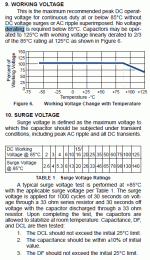Hi,
I have a pair of vintage speakers with built in amps (to power the woofers). But one of the amp keeps blowing fuse (the one in the RED circle highlighted)

I understand it is very hard to diagnoise this kind of issue. But I want to know which components that most likely failed has caused the issue.
Thanks a lot for the help,
I have a pair of vintage speakers with built in amps (to power the woofers). But one of the amp keeps blowing fuse (the one in the RED circle highlighted)
I understand it is very hard to diagnoise this kind of issue. But I want to know which components that most likely failed has caused the issue.
Thanks a lot for the help,
Everything is easy for the person who knows it and ...
The transistors that r fitted on the heatsink r blown. If u test them on a Multimeter, u will find that the Collector & Emitter is shorted. Replacing them may not lead to a total repair as other transistors will generally follow suit (design dependent).
In case u intend to fix it yourself, replace the fuses with 100-150 ohms, 2W resistor and test after u replaced the faulty components. U will prevent further damage if the amp is still having a fault.
In this amp, u cannot disconnect the driver, while testing.
Never change only one transistor, also change the corresponding transiator that complements it.
Gajanan Phadte
The transistors that r fitted on the heatsink r blown. If u test them on a Multimeter, u will find that the Collector & Emitter is shorted. Replacing them may not lead to a total repair as other transistors will generally follow suit (design dependent).
In case u intend to fix it yourself, replace the fuses with 100-150 ohms, 2W resistor and test after u replaced the faulty components. U will prevent further damage if the amp is still having a fault.
In this amp, u cannot disconnect the driver, while testing.
Never change only one transistor, also change the corresponding transiator that complements it.
Gajanan Phadte
Last edited:
Hi Gajanan,
Thank you so much for the info. I will try it out and let you know how it goes.
These speakers were made in France. You must know them well. There was a thread here about these speakers:
http://forum.vintage-audio-laser.com/ecoute/master-control-t5336.html
Best regards,
Singzh
Thank you so much for the info. I will try it out and let you know how it goes.
These speakers were made in France. You must know them well. There was a thread here about these speakers:
http://forum.vintage-audio-laser.com/ecoute/master-control-t5336.html
Best regards,
Singzh
Last edited:
Hi,
Since the negative fuse is the only one that is blowing the transistors that will caused to blow it are TR107,TR105 and possible D107.
Since the negative fuse is the only one that is blowing the transistors that will caused to blow it are TR107,TR105 and possible D107.
While you are at it replace C112 and C113...'Tantalums' they age badly and end up shorting....use standard electrolytics.
Just change the outputs and the drivers, check the W/W resistors and change those tantalums. Should be fine. Test with 47 ohm resistor where the speaker fuse is and make sure no d.c. on the output with volume down. (no signal)
Thanks gentlemen for the suggestions.
I measured all transistors and I could find any obvious failures.
New observation: if I do not connect the woofer, then the fuse is fine. as long as I connect a woofer to the circult (I even tried with another new woofer), the fuse blows right away.
Any idea?
I measured all transistors and I could find any obvious failures.
New observation: if I do not connect the woofer, then the fuse is fine. as long as I connect a woofer to the circult (I even tried with another new woofer), the fuse blows right away.
Any idea?
The reason it only blows the fuse when the speaker is connected is that the amp is putting DC on the output, but until there is a load there - the speaker - to draw current, no current flows, so the fuse is OK. COnnect a speaker and you essentially have the speaker across your powr supply. Fuse blows.
While you are at it replace C112 and C113...'Tantalums' they age badly and end up shorting....use standard electrolytics.
Perhaps a bit off-topic, but...I find this remark about tantalums somewhat strange. (Solid) tantalums will hardly age in decades, even under difficult circumstances.
In industrial electronics tantalums are used abundantly. The (small) company I work for places literally millions of tantalums a year, and failure rate - with the exception below - is as low as other types.
We've seen boards returned for repair after a decade of continuous use on which the tantalums were still as new.
Having said this, I know tantalums are prone to self destruction and thermal runaway under certain conditions, but this only happens when the designer didn't leave enough margin for error. We have seen this phenomenon wit certain values of SMD tantalums, especially in the beginning of the RoHS-compliance era.
When RoHS-compliance became mandatory for industrial electronics too (2006), we found some values of tantalums were prone to sudden and explosive failure at first power up despite being placed correctly and within voltage tolerance, or so we thought.
After some research our customers found their designs didn't use the correct voltage tantalums. Contrary to electrolytics, a tantalum should have a remarkably higher voltage ability than the working voltage. In other words using, e.g., a 16 V tantalum in a 12 V circuit will increase risk of premature failure significantly, a 20 V type should be used in normal conditions and 25 V in severe conditions (see attachment).
After our customers revised the tantalums to a higher voltage type, these problems disappeared.
Attachments
Last edited:
Thanks Jitter, I have had to replace hundreds of tantalums and lost faith......To be fair, I have changed thousands of electrolytics too but then they are MUCH more common.
In industrial, communications, military and audio electronics, I have learned not to trust them. Maybe its just me..? Cheers
In industrial, communications, military and audio electronics, I have learned not to trust them. Maybe its just me..? Cheers
And yes indeed, this may be why.
"a 16 V tantalum in a 12 V circuit will increase risk of premature failure significantly, a 20 V type should be used in normal conditions and 25 V in severe conditions (see attachment)."
Electrolytics are a little less critical! 🙂
"a 16 V tantalum in a 12 V circuit will increase risk of premature failure significantly, a 20 V type should be used in normal conditions and 25 V in severe conditions (see attachment)."
Electrolytics are a little less critical! 🙂
Hi Jitter,
further to the data you posted.
Do other Tantalum Manufacturers similarly de-rate their caps?
To All,
my understanding of the marked voltage on a capacitor is that this is the maximum working voltage that the Manufacturer is guaranteeing there will be very few failures if used within specification.
Why do the normal Marking of safe maximum working voltage not apply to Vishay Tantalum?
further to the data you posted.
Do other Tantalum Manufacturers similarly de-rate their caps?
To All,
my understanding of the marked voltage on a capacitor is that this is the maximum working voltage that the Manufacturer is guaranteeing there will be very few failures if used within specification.
Why do the normal Marking of safe maximum working voltage not apply to Vishay Tantalum?
Hi,
Swap transistors TR106 and TR107. If TR106 it is failing under load it will blow then the negative fuse. You will know if the transistor is good.
Swap transistors TR106 and TR107. If TR106 it is failing under load it will blow then the negative fuse. You will know if the transistor is good.
Hi Jitter,
further to the data you posted.
Do other Tantalum Manufacturers similarly de-rate their caps?
Yes, indeed. We also use Kemet a lot, and they have similar deratings, see attachment.
To All,
my understanding of the marked voltage on a capacitor is that this is the maximum working voltage that the Manufacturer is guaranteeing there will be very few failures if used within specification.
Why do the normal Marking of safe maximum working voltage not apply to Vishay Tantalum?
The datasheet distinguishes between "working voltage" and "application voltage". The rule of thumb our customers apply and which we recommend to those who are still unaware of voltage derating of tantalums (more that you'd think!), is to use a working voltage of at least twice the application voltage.
Perhaps tantalums got a bad reputation for the wrong reasons. It's clear to me now that comparing tantalums with, e.g., electrolytics is like comparing apples with pares. Different design rules apply. Use the correct rules, and there's no problem.
Attachments
Just looked at the datasheet of the leaded tantalums of Kemet. The derating to 50% of working voltage doesn't seem to apply to through hole types, only to SMD tantalums.
This might explain why we only experienced the phenomenon with SMD tantalums and never with through hole tantalums.
This might explain why we only experienced the phenomenon with SMD tantalums and never with through hole tantalums.
Attachments
- Status
- Not open for further replies.
- Home
- Amplifiers
- Solid State
- Help needed: speaker internal amp blows fuse


